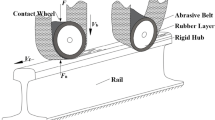Abstract
Rail grinding has become an increasingly permanent way maintenance practice to tackle rail corrugation, as well as extending the rolling contact fatigue life of rails. However, and as far as material loss is concerned, such a grinding is considered as an artificial wear process added to the natural wear. The work presented in this article investigates the quantitative effect of grinding the whole deformed rail surface layer on the overall wear process of the running surface of pearlitic rail steel. Results show that if wear behavior is known as an empirical model which can predict the effect of grinding that could be obtained.







Similar content being viewed by others
Abbreviations
- a, b :
-
Constants
- E :
-
Contact modulus
- E 1 , E 2 :
-
Young’s modulus of materials 1 and 2, respectively
- F :
-
Applied contact load
- Gp :
-
Maximum number of possible grindings
- H o :
-
Original height before wear or grinding
- H c :
-
Condemning height of wearing surface
- Hd :
-
Deformed depth
- Hs :
-
Remaining height at steady state
- N :
-
Number of rolling–sliding load cycles
- Ns :
-
Number of rolling–sliding load cycles for the onset of steady state
- n :
-
Number of grindings
- Po :
-
Contact pressure
- R :
-
Contact radius
- R 1 , R 2 :
-
Radii of the two contacting bodies
- Rh 0 :
-
Remaining height of the wearing surface (for the case of no grinding)
- Rh :
-
Remaining height of the wearing surface
- Rh n :
-
Remaining height of the wearing surface after n grindings
- ξ :
-
The percentage effect of grinding
References
Linn, S., Abell, D., Kalousek, J., Sroba, P.: Planning of Production Rail Grinding on Burlington Northern Railroad. IHHA, Beijing, China (1993)
American Railway Engineering and Maintenance of Way Association. Track Measurement Systems, Definitions of Rail Surface Conditions, section 1.1, (1994)
Sharif, A.: Dynamic Performance Investigation of Base Isolated Structures, PhD thesis, submitted to the Department of Civil Engineering, Imperial College of Science, Technology & Medicine, London University. (2000)
Salaiova, B., Koval’akova, M.: Prediction of noise from Tram. Appl. Acoust. 63(4), 351–465 (2002)
Magel, E., Roney, M., Kalousek, J., Sroba, P.: The blending of theory and practice in modern rail grinding. Fatigue Fract. Eng. Mater. Struct. 26, 921–929 (2003)
Tyfour, W. R.: Effect of moving sand as ballast contaminant on rail surface corrugation (Submitted for publication in Jordan J. Mech. Indus. Eng.)
Jin, X., Wen, Z., Wang, K., Wang, W.: Effect of a scratch on curved rail on initiation and evolution of rail corrugation. Tribol. Int. 37(5), 385–394 (2004)
Tyfour, W. R.: Effect of inclusion geometry and matrix properties on rolling contact fatigue of steel. J. Mu’tah Res. Stud. Natural and applied sciences series, 15(1), 135–149 (2000)
deVries, Robert, Sroba, P., Magel, E.: Preventive Grinding Moves into the 21st Century on Canadian Pacific Railway. Proceeding of AREMA, Chicago, USA, (2001)
Tyfour, W. R., Beynon, J. H., Kapoor, A.: The steady state wear behaviour of pearlitic rail steel under dry rolling-sliding contact conditions. Wear 180, 79–89 (1995)
Garnham, J., Beynon, J. H.: the early detection of rolling-sliding contact fatigue cracks. Wear 144, 69–94 (1991)
Timoshenko, S.P., Goodier, D. N.: Theory of Elasticity. McGraw-Hill, UK (1970)
Acknowledgment
The author would like to express his thanks to Aqaba Railway Corporation of Jordan for their support.
Author information
Authors and Affiliations
Corresponding author
Rights and permissions
About this article
Cite this article
Tyfour, W.R. Predicting the Effect of Grinding Corrugated Rail Surface on the Wear Behavior of Pearlitic Rail Steel. Tribol Lett 29, 229–234 (2008). https://doi.org/10.1007/s11249-008-9300-y
Received:
Accepted:
Published:
Issue Date:
DOI: https://doi.org/10.1007/s11249-008-9300-y




